Jane Seymour
Jane Seymour, Ltd. (capital £1,000) was founded in 1933. I have been unable to determine who established the company before it was listed as a subsidiary of J. C. & J. Field, Ltd. in 1958. I have no records of Field either starting Jane Seymour in 1933 or buying it between then and 1958 so the issue remains unsettled.
The person of Jane Seymour was a fabrication of the company owners and all representations of her are drawings. As Robert A. Lodge, the managing director of Jane Seymour, explained, this was done to make Jane Seymour cosmetics more appealing to women.
We were swayed by the fact that we were appealing exclusively to women. Women talk to each other about their problems of make-up, removing wrinkles from the skin, reducing or putting on weight and so on. It was logical, then, for us to speak to them through the person of a woman who would advise and help them on problems such as these. We therefore created Jane Seymour.
(Lodge, 1936, p. 23)
Jane Seymour also tried to make its products more appealing to women by adopting a conversational approach in its advertising. Jane Seymour always talks with another woman about their beauty problems, offering suggestions and solutions.
Coincidentally, the film ‘The Private Life of Henry VIII’ starring Charles Laughton [1899-1962] as King Henry VIII [1491-1547] and Wendy Barrie [1912-1978] as Jane Seymour [c.1508-1537], Henry’s third wife, was released a few months after Jane Seymour, Ltd. was founded. There were a few attempts by the company to capitalise on this connection but these disappeared after 1934.
After it was established, Jane Seymour opened a salon at 23 Woodstock Street, off Bond Street in Mayfair as a base for its extensive line of cosmetics. Despite being established in the middle of the Great Depression, the business appears to have prospered with sales up 168% between 1934 and 1935, partly due to expansion into three foreign markets. Increased growth also saw the Jane Seymour salon move to larger, more impressive premises at 21-22 Grosvenor Street in 1937. Information about the salon treatments is very sparse but they included full body massages, facials, hair shampoos and sets, manicures, pedicures, weight reduction treatments, wax depilatory treatments, and make-overs.
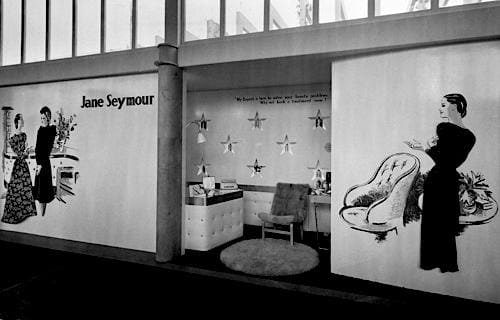
Above: 1938 Jane Seymour stand at the Empire Exhibition, Glasgow. Each of the stars in the wall contains a Jane Seymour product, a design feature that was also used in the new Jane Seymour salon in Grosvenor Street.
As well as expanding across Britain, Jane Seymour was available through outlets in some parts of British Empire, including Canada, Australia, New Zealand, and South Africa. I don’t have evidence that the company established other Jane Seymour salons in Britain, although some privately owned salons may have used its products, but it did set up Jane Seymour salons in other countries. Two overseas salons that I know of were the Jane Seymour Beauty Salon in 47 Queen St., Auckland, New Zealand, and another in the Farmer’s Department Store in Pitt Street, Sydney.
Products
The initial range of Jane Seymour cosmetics, introduced in 1933, focussed mainly on skin-care rather than make-up and included products such as Jane Seymour Cleansing Cream, Cleansing Milk, Astringent Lotion, Juniper Skin Tonic, Anti-Wrinkle Cream, Foundation Cream, Petal Lotion, Complexion Milk, Hand Lotion, and Cosmetic Pads. The products were packaged in rectangular bottles or round jars with Art Deco inspired labels, then considered very fashionable.
Skin-care
Jane Seymour sold a range of cleansers, skin foods and tonics/astringents. Skin foods could also be supplemented with Jane Seymour Muscle Oil if needed.
Cleansing Milk: “[A] cleanser and a splendid tonic for too-oily pores.”
Juniper Skin Tonic: “[A] herbal tonic which must be patted well into the face. It has stimulating effect which is of great assistance in maintaining a good complexion.”
Astringent Lotion: “[T]o close those pores.”
Orange Skin Food: “The rich nourishment soaks right in— leaving only a smell residue.”
Peach Skin Food: “[C]ontains the sunshine vitamins the best possible restorative for a neglected skin.”
Pore Cream: “[T]o reduce oiliness and bring big pores back to normal.”
Greaskin Cream: “[N]ourishes the under tissues without adding more oil to the surface;”
Jane Seymour skin-care cosmetics were used in treatments based on beauty principles commonly accepted in the 1930s. Diet and exercise were considered to be important to skin health but the skin also had to be cleansed to remove surface grime, to allow it to ‘breathe’, and to remove barriers to absorption of the ‘nutrients’ in the skin foods that followed. The skin was also massaged to improve circulation and stimulated with astringents often combined with face slapping. Astringents were also used before applying make-up to close the pores of the skin so that they would not be blocked with a foundation or face powder.
See also: Skin Tonics, Astringents and Toners and Skin Foods
Jane Seymour sold a number of different cleansers, skin foods, and astringents which were selected according to whether the skin was diagnosed as Normal, Dry, or Greasy.
Normal skins: Cleansing Cream, Peach Skin Food, Juniper Skin Tonic.
Dry skins: Cleansing Cream, Orange Skin Food, Juniper Skin Tonic.
Greasy skins: Cleansing Milk, Greaskin Cream, Pore Cream, and Astringent Lotion.
Jane Seymour was not in favour of washing with soap and water, except where the skin was very greasy. At night, the face and neck was therefore cleansed with Cleansing Cream or Cleansing Milk depending on the skin type, after which Peach or Orange Skin Food or Greaskin Cream was patted into the skin. If the skin was very greasy, Pore Cream was to be used instead of Greaskin Cream for a week or ten days in order to refine the pores of the skin, after which Pore Cream and Greaskin Cream were used on alternate nights. In the morning the skin was cleansed and stimulated with Juniper Skin Tonic, or Astringent Lotion before a suitable make-up was applied.
Towards the end of the decade there are suggestions that Jane Seymour was making allowances for semi-dry, semi-greasy skin; i.e., what would now be thought of as Combination skin.
Wash your face and neck at night with Cleansing Cream and Juniper Skin Tonic. Then pat in Peach Skin Food, but keep clear of your nose. On and round your nose use Cleansing Milk—which is a slight astringent—and a little Pore Cream. It will bring the pores back to normal—and reduce grease.
Be sure to brace with plenty of Juniper in the morning. You’ll soon find that regular care improves your circulation—and brings your nose into line with the rest of your face, so to speak!(Jane Seymour advertisement, 1939)
Special treatments were also offered for a range of problem conditions.
Blackheads: The affected skin was first bathed in warm water or steamed to open the pores after which Jane Seymour Blackhead Paste was applied. This was left on for an hour or overnight after which it was washed off and the skin rubbed fairly hard with a rough towel. An astringent was then applied to close the pores, with Jane Seymour Pore Cream applied over the site of the blackheads at night. This treatment could be repeated daily if the skin was Greasy or every second day if the skin was Dry.
Acne: Acne sufferers were advised to exercise more, follow the diet recommended by Jane Seymour and give up using all greasy creams. Jane Seymour Acne Lotion was to be applied at night after the face had been washed and the skin was also braced with Jane Seymour Astringent Lotion in the morning. The Acne Lotion could also be used to cover spots or as a foundation if the acne was extreme.
Wrinkles: For wrinkles, Jane Seymour recommended its Anti-Wrinkle Cream which was supposed to nourish the underlying tissues and gradually smooth out the lines. It was patted into the skin after cleansing, working upwards and outwards while being careful not to stretch the skin. After being left on for half-an-hour it was removed using Juniper Skin Tonic or Astringent Lotion. The skin was also be ‘fed’ with Orange Skin Food several times a week.
Bleaching: Jane Seymour Cleansing Lotion acted as a mild bleach but if something stronger was needed, as for example to remove a ‘tired tan’, then the stronger Jane Seymour Bleaching Cream was recommended.
Eye treatments: Tired eyes could be bathed in Jane Seymour Eye Lotion while the whites could be cleared with Jane Seymour Eye Drops. Crow’s feet required patting with Jane Seymour Anti-Wrinkle Cream. It was left on while the eyes were rested under Jane Seymour Eye Pads that had been wrung out after being soaked in hot water. After resting, the cream was removed with Jane Seymour Juniper Skin Tonic.
Conturing: Clients that wished to lose weight could follow diet regimes available on request but Jane Seymour also subscribed to the idea that vigorous massage could be used to remove excess fat. These reducing massage treatments, supplemented with Jane Seymour Reducing Cream, were available at the Jane Seymour salon to remove excess fat from the stomach, thighs, upper arms, ankles or back.
Reducing Cream: “[B]reaks down the fatty cells without affecting firm and healthy tissues.”
Flabby chins were treated in the usual way with massage, skin foods, astringents, and chin straps.
See also: Chin and Throat Treatments
Biological additives
Like many other cosmetic companies, Jane Seymour included vitamins in some of its skin-care cosmetics. This began with Jane Seymour Peach Skin Food, which was formulated with vitamin D, the ‘sunshine vitamin’. Jane Seymour claimed that it could ‘put new life into [Dry or Greasy] skin after it has been starved of light and fresh air during the winter’.
By 1936, Jane Seymour had added Jane Seymour Vitamin Cream which contained vitamins A, B, C, and D. Suggested for women over thirty it was particularly promoted as a treatment for a crepey neck.
A vitamin cream should be used by women of thirty whose necks are beginning to foreshadow loose skin. It contains a generous supply of vitamins on absorbent base. If a hot towel is placed round the neck to open the pores, and then the cream is gently but lavishly worked in, and the neck is bound with a linen handkerchief a little later to encourage assimilation, and left for three or four hours.
(Jane Seymour advertisement, 1937)
Vitamin Cream: “Its effect on a neglected skin is simply amazing. It smoothes out lines, revitalises the tissue and makes the whole face ‘live again.’
See also: Vitamin Creams
A second cream containing a biological additive was Jane Seymour Hormone Cream. Introduced by 1936, it came in two strengths, one for the over forties and a stronger formulation for the over fifties.
Hormone Cream: “It is a scientific preparation and will make up for the deficiencies of your vital glands which function less actively as you get older.”
See also: Hormone Creams, Oils and Serums
Masks
Jane Seymour had two products that were described as masks. The first, Jane Seymour Stimulating Cream, appears to have been a circulation cream. It contained an irritant that reddened the skin so could only be left on the face for a limited time.
Stimulating Cream: “[A]pplied and left on for three minutes after the bath, whips up like magic on a dry skin. It tingles; it freshens; but three minutes is the limit. Then, it should be wiped off with skin-tonic. Make-up can go on straight away.”
See also: Circulation (Blood Glow) Creams
A second product, the Jane Seymour Rejuvenating Mask, was a creamy mask that was smoothed on the face and neck after the skin was cleansed. If the skin was Dry it was washed off in warm water after ten minutes but women with Greasy skin were recommended to leave it on for twenty minutes. After it was removed the skin was brace with Juniper Skin Tonic or Astringent Lotion depending on the skin type.
Rejuvenating Mask: “[T]akes longer to work, is thicker, and should only be used once a week.”
Arms, hands and nails
Like most salons, Jane Seymour included manicure treatments in her salon. She also sold a hand cream and a hand lotion, as well as a hand pack. These could be used together in the salon or as home treatment for the hands and arms.
The treatment required the hands and forearms to first be washed in warm soapy water. The hands were then massaged with Jane Seymour Hand Cream while they were still warm. The cream was left on for ten minutes after which any excess was wiped off with a tissue. Next came the Jane Seymour Hand Pack, a cream made up by mixing the ingredients in the pack with cold milk. It was applied over the forearms and elbows and left on for 15 minutes, after which it was wiped off with a warm, wet towel. Jane Seymour Hand Lotion was then smoothed into the hands to finish the treatment.
Nails were treated at home with Jane Seymour Cuticle Cream at night, wiped away with cotton wool soaked in Jane Seymour Cuticle Remover in the morning. The nails are then ready for polish. There is a strong possibility that Jane Seymour made a nail polish before the war but, unfortunately, I don’t have enough evidence to confirm this.
Sun-care
In 1934, Jane Seymour introduced three cosmetics for women who wanted to develop a fashionable tan. Sun Tan Oil was used when sunbathing to brown the skin, followed later with Sunbalm Lotion to soothe it. Women who could not get to the beach or sunbathe could artificially tan their skin with Jane Seymour Bronzing Lotion. Sun Tan Bloc was added to the range in 1936. Like the Sun Tan Oil it was used when suntanning but came without the oily feel.
Sun Tan Oil: “[E]ssential for those who sunbathe.”
Bronzing Lotion: “[C]reates artificial tan; it is water-proof but may be removed with soap or cleansing cream.”
Sunbalm Lotion: “[T]o be used after exposure to wind or sun.”
Sun Tan Bloc: “It turns you a lovely even brown without reddening or peeling —and it’s so much cleaner than oil.”
Make-up
Jane Seymour included what appears to be a vanishing (foundation) cream in its original product range but I don’t have any evidence for other forms of make-up until 1934. In 1935, Jane Seymour introduced a non-spill plastic powder box with a green base and an ivory, screw-on lid that had a corked rim to help seal the container. The powder came in two weights, one for dry and the other for greasy skins. Matching ivory and green containers were also produced for a new refillable indelible lipstick, a paste rouge, and eye shadow.
Foundations
Jane Seymour had a number of products that could be used as a foundation. In addition to the original Jane Seymour Foundation Cream the company also sold Jane Seymour Petal Cream for women with Dry skin and Petal Lotion for those with a Greasy skin type. The Foundation Cream was colourless but both the Petal Cream and Petal Lotion were shaded to colour coordinate with the shades of Jane Seymour face powders. Petal Cream was most likely a tinted vanishing cream but Petal lotion was a liquid powder suspension, an unusual choice for a foundation as this type of cosmetic was more commonly used in the evening to whiten the arms and decolletage. Jane Seymour also recommended that it could be used in this fashion.
Petal Cream: “[A] foundation specially for dry skins, and a day-long protection against shininess.” Known shades: Natural, Magnolia, Almond Blossom, Dawn Rose, Magnolia, Peach, Light Peach, Golden Gleam, Honey Bloom, and Blush.
Petal Lotion: “[A] liquid powder that does not rub off; it protects the skin and is ideal without powder for country make-up, and it is excellent for the back and arms when evening dress is worn.” Shades: As for Petal Cream.
See also: Liquid Face Powders
Other Jane Seymour suggestions for foundations under particular conditions included Jane Seymour Anti-Weather Cream (1935), Special Protective Cream (1937), Winter-skin Cream (1938), and Acne Lotion.
Anti-Weather Cream: “[Used] as a foundation. It is a wonderful protection against wind, sun, redness and chafing.”
Special Protective Cream: “[Has a] satin smooth texture, is readily absorbed by the skin, and can be used to advantage as a powder base by people with dry skins.”
Winter-Skin Cream: “[C]an go on any complexion as a protective film against weather, because it is a film that is a filter through which the skin can breathe.”
Although not strictly a foundation I also make mention here of Jane Seymour Mattne which was used under powder to reduce nose shine.
Mattne: “[F]or nose shine; must be applied with the finger-tips”
Face powder
Jane Seymour sold two face powders, Dryskin Powder for Dry skin types and a heavier Greaskin Powder for Greasy skins. They came in the same twelve shades and were strongly recommended to be used over an appropriate foundation.
Dryskin Face Powder: “[F]or the ‘dries,’ which should be used with a foundation of Petal Cream.” Known shades: Natural, Light Peach, Oyster, Peach, Tamarisk, Sun Bronze, Banana, Honey Bloom, and Night Green with Dawn Rose added in 1935.
Greaskin Face Powder: “[F]or the ‘oilies ’—with its companion foundation of Petal Lotion.” Shades: as for Dryskin Face Powder.
As its name suggests Night Green was a green powder for florid faces. Jane Seymour recommended it be ‘used with discretion’.
Lipsticks
The first Jane Seymour Lipstick I have records for appeared in 1934. The lipstick previously mentioned from 1935 was an indelible, packaged in a ivory and green refillable container in six shades referred to by number, with a seventh shade added by 1938. Despite the numbers, the shades also appear to have been given names, for example, No. 3 was also referred to as Deep Rose, and No. 6 was Mulberry.
Indelible Lipstick: “Put it on—wipe off any superfluity— and the colour still remains! And it never gives the lips that dried, drawn look.” Known shades: Deep Rose, Mulberry, Golden Gleam, and Honeyblush.
Rouge
Jane Seymour sold both a Paste (cream) and Powder Rouge in the same shades. The Paste Rouge was recommended for women with Dry skin types, while the Powder rouge was considered more suitable for those with Greasy skin. Known rouge shades were Peach, Fuchsia, Coral, Sun, Rose, Ash Rose, Rose Blonde, and Honeyblush.
Eye make-up
Information of Jane Seymour eye make-up before the war is very sparse but I record indicate that the company did make eye shadow and a block mascara. Given this, it seems highly likely that it also made an eyeliner.
Colour coordination
Jane Seymour provided clients with colour charts to help them colour coordinate their foundations, rouge, lipsticks, and face powders based on skin and hair colour. Some of these are listed below:
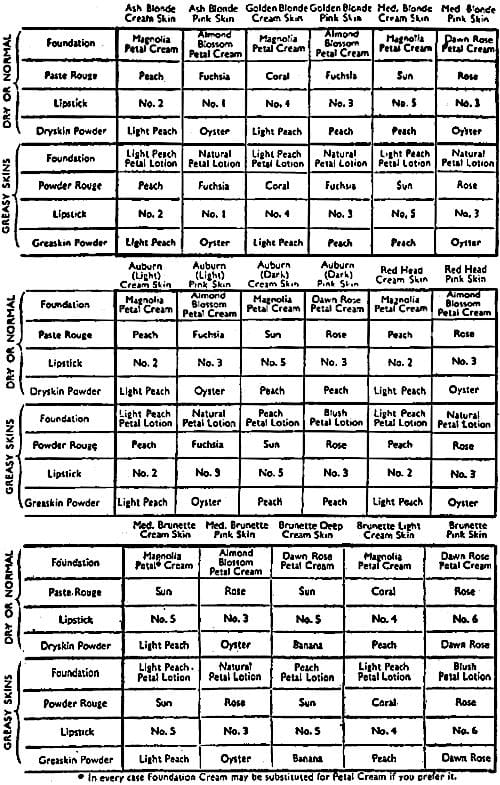
Above: 1939 Jane Seymour colour coordination charts.
War
Jane Seymour cosmetics sold overseas were fully imported so when the Second World War broke ou Jane Seymour operations in places like Australia, Canada, New Zealand and South Africa were forced to close and did not reopen until after the war.
Fortunately, the London salon remained intact during the Blitz. However, war shortages forced Jane Seymour to discontinue production of some items such as mascara, perfumes and beauty cases and like many other firms it stopped taking mail orders. Women had to rely on supplies reaching shops close to them.
Post war
In 1948, Jane Seymour introduced Petal Dust, a new face powder in Dryskin and Greaskin weights in Dawn Rose, Apple Blossom, Oyster, Magnolia, Peach, Tamarisk, Columbine, Honey Bloom, Banana, Sunbronze, Eau-de-Nil and the new Admiration shade. Eau-de-Nil was a replacement for the Night Green shade used to reduce florid complexions before the war.
The powder could be applied over Jane Seymour Foundation Cream, Petal Cream or Petal Lotion. The shade ranges for the tinted foundations were now Magnolia, Almond Blossom, Dawn Rose, and Honey Bloom with Blush also available in Petal Lotion.
Jane Seymour Lipsticks now came in nine shades – Sampler Pink, Momento, Orange Pippin, Red Coat, Posy, Bracken, Plush, Crimson Osprey, and Tyrian Rose. These shades were to be matched with either cream or compressed powder rouge. The cream rouge came in five shades – Sugar Almond, Firelight, Sealing Wax, Crinoline, and Pimpernel – the compressed rouge in four shades – Cachou, Cany, Rose Mousse, and Macaroon.
To complete their make-up, women could select Jane Seymour Mascara and Jane Seymour Eye Shadow in Cobalt, Blue, Green, Mauve, and Silver shades.
To help revitalise the line Jane Seymour repackaged its products in 1949 abandoning the Art Deco designs of the 1930s which now looked dated. The company made further adjustments in 1951, replacing the labels on the containers to make them easier to read.
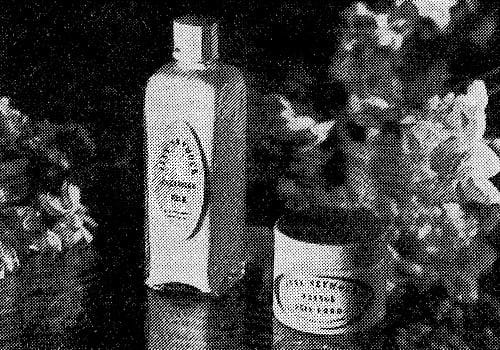
Above: 1951 Jane Seymour bottles and jars with new labels.
There do not not appear to have been any further developments in the Jane Seymour range until J. C. & J. Field was bought by Griffiths Hughes in 1958 and Jane Seymour was sold as a part of D. R. Collins, Ltd. to Douglas Collins. This may also have been when the Jane Seymour salon was closed. Following the sale, D. R. Collins developed the Jane Seymour Wonder Girl series, which looks to have been aimed at younger women, and added talcum powders, bath cubes and skin perfumes all in Blue Gardenia, and Embrace fragrances.
Wonder Girl
The first new product in the Wonder Girl range was Wonder Puff (1958), a compact make-up. The compact came in two refillable forms, a plastic Star compact and one made from metal, both available in six shades – Temptation, Florida Rose, Lovely Pink, Honey Blonde, Stardust, and Calypso, with Capri Tan added in 1959. The only other shade I know of was Iced Pearl, a green powder that functioned like the earlier Eau-de-Nil and Night Green.
Wonder Puff was quickly followed with Wonder Base, Wonder Tint, Wonder Lipsticks, and White Wonder (1959); Wonder Mascara in Black Coffee, Sable Brown, Italian Blue, and Jungle Green shades, Wonder Eye Shadow, and Wonder Automatic Eye Pencil (1960) in Blue, Green, Grey, Light Brown, and Blackish Brown shades. There appears to have also been a Wonder nail polish which came in shades that matched the Wonder Lipstick. Unfortunately, the only lipstick and nail polish shades that I know of were Cool Pineapple, Paradise Pink, and Sahara Red.
Like the older Jane Seymour Petal Cream and Petal lotion, Wonder Base and Wonder Tint were to be used on different skin types. Wonder Base was recommended for women with Dry or Sensitive skins while Wonder Tint was suggested for those with Oily skin types. Both came in the same five shades – Invisible, Magnolia, Oyster, Golden Dawn, and Honey Gold.
Jane Seymour proposed that Wonder Base or Wonder Tint could be used by women to create different ‘looks’. They could also extend the clothing colours they could wear by using Wonder Base or Wonder Tint to change the colour of their complexion. This idea combined the postwar interest in ‘looks’ started by the introduction of Cristian Dior’s [1905-1957] ‘New Look’ in 1947 with Elizabeth Arden’s [1881-1966] idea that women can use make-up so that they could wear any colour, something she began promoting back in 1931.
See also: Elizabeth Arden (1930-1945)
In advertorials, Jane Seymour explained how different looks could be achieved. Two examples are given below:
The “Dresden” Look—delicate and feminine, but sophisticated too. Pastel or silver shadow for eyes and lips must be pink.
Clothes: understated colours and lines. Silks, satins, velvets, lace. Make up: Oyster, a soft pink, ivory shade.
The “English Rose” look—pink, white and pretty. Eyes must be softly made up and lips rosy.
Clothes: Swirling skirts, organdie, crisp cotton. Bows and parasols. Pastel shades and flowers.
Make up: Magnolia, a soft pink for medium or sallow skins.(Jane Seymour advertorial, 1959)
White Wonder lipstick was one of the more interesting items in the Wonder range. It joined a number of white lipsticks introduced around this time used under of over lipsticks to lighten their colour. Jane Seymour went further than this, suggesting that White wonder could be also used on eyelids to give them a soft luminous look, under or over eyeshadow to vary its depth of colour, as a spot concealer, to add contours to the face, and even as a hair highlighter.
White Wonder: “[A]ny lipstick shade can be lightened, and made to change tone.”
When Reckitt & Colman, Ltd. bought D. R. Collins in April, 1960 it acquired Jane Seymour along with Goya, and Care Laboratories. The new owners continued with the Wonder Girl series adding Wonder Cream in 1960, and Wonder Set hair spray, and Wonder Hand Cream in 1961.
Wonder Cream contained lanolin, cholesterol and the antiseptic hexachlorophene and was sold in tubes in two sizes. Jane Seymour claimed it could be used as a nourishing cream or as a foundation. The presence of hexachlorophene mean that Jane Seymour also recommended it for sore and chapped skin as well as children’s cuts and grazes. Surprisingly, I have not found it recommended for pimples.
See also: Hexachlorophene
Later developments
Reckitt & Colman sold D. R. Collins, Ltd. back to Douglas Collins in 1968. Deciding that they were not interested in maintaining the Jane Seymour line, D. R. Collins sold Jane Seymour to Rimmel in 1969.
Rimmel underwent a number of owners in the years that followed but, somehow or other, Jane Seymour has managed to survive in a small way. As far as I can tell, the only Jane Seymour products on the market today are hair styling products such as Wonder Set and they are only available through a Jane Seymour company based in South Africa.
Timeline
| 1933 | Jane Seymour founded in London. New Products: Cleansing Cream; Cleansing Milk,; Astringent Lotion; Juniper Skin Tonic; Anti-Wrinkle Cream; Foundation Cream; Petal Lotion; Complexion Milk; Hand Lotion; and Cosmetic Pads. |
| 1934 | New Products: Sun Tan Oil; Bronzing Lotion; and Sunbalm Lotion. |
| 1936 | New Products: Sun Tan Bloc. |
| 1937 | Salon moves to 21-22 Grosvenor Street, London. New Products: Special Protective Cream. |
| 1948 | New Products: Petal Dust Face Powder. |
| 1949 | Jane Seymour range repackaged. |
| 1958 | D. R. Collins, Ltd., including Jane Seymour sold to Douglas Collins. New Products: Wonder Puff. |
| 1959 | New Products: Wonder Base, Wonder Tint, Wonder Lipsticks; and White Wonder. |
| 1960 | Reckitt & Colman, Ltd. buys D. R. Collins, Ltd. which includes Jane Seymour. New Products: Wonder Cream; Wonder Mascara; Wonder Eye Shadow; and Wonder Automatic Eye Pencil. |
| 1961 | New Products: Wonder Set; and Wonder Hand Cream. |
| 1968 | Douglas Collins buys D. R. Collins, Ltd. which includes Jane Seymour. |
| 1969 | Jane Seymour sold to Rimmel Ltd. |
First Posted: 10th October 2024
Sources
The Drug and Cosmetic Industry. (1932-1997). New York: Harcourt Brace Jovanovich [etc.].
Lodge, R. A. (1936) London beats the world as a beauty centre.

1933 Jane Seymour.
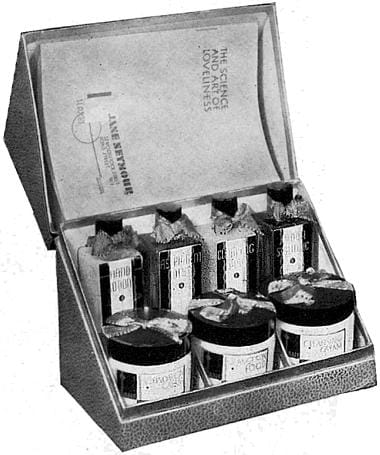
1933 Jane Seymour Trial Beauty Box containing four lotions (Hand Lotion, Astringent Lotion, Cleansing Lotion, and Juniper Skin Tonic), three creams (Foundation Cream, Orange Skin Food, and Cleansing Cream) and a product brochure.
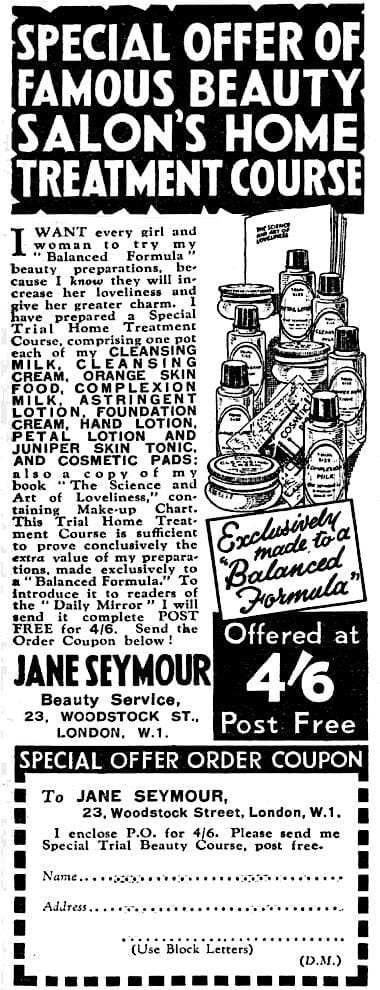
1933 Jane Seymour.

1934 Jane Seymour.
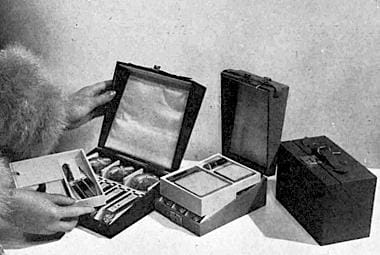
1934 Jane Seymour beauty boxes. Note the lipstick and mascara in the largest case.
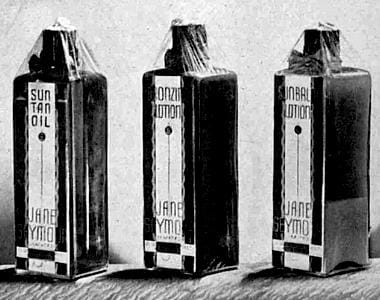
1934 Jane Seymour Sun Tan Oil, Bronzing Lotion, and Sunbalm Lotion.
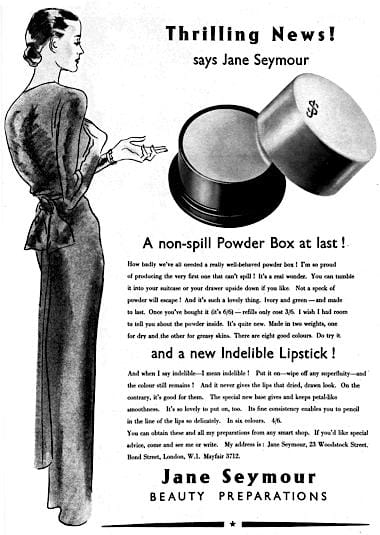
1935 Jane Seymour non-spill powder box.

1935 Jane Seymour non-spill powder box with a screw-on, cream-coloured lid with a corked rim, green base and puff.
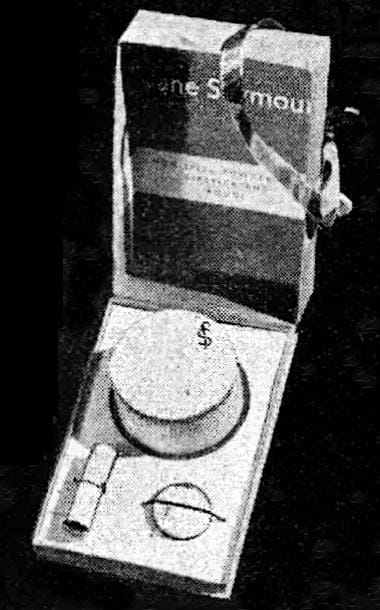
1935 Jane Seymour Beauty Box – Non-spill Powder, Lipstick and Rouge.
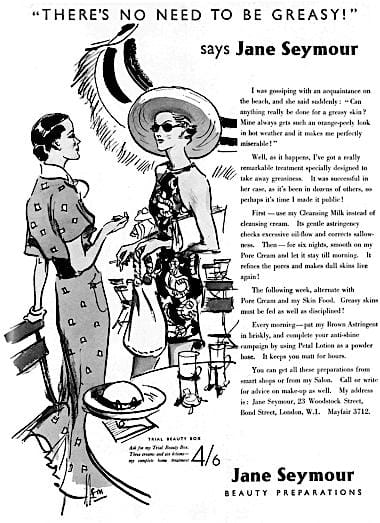
1935 Jane Seymour.

1935 Jane Seymour Beauty Service display.
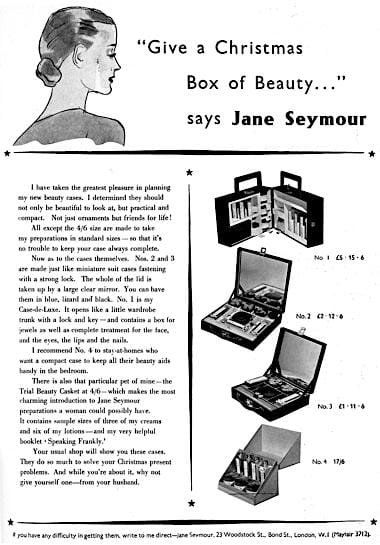
1935 Jane Seymour beauty boxes.
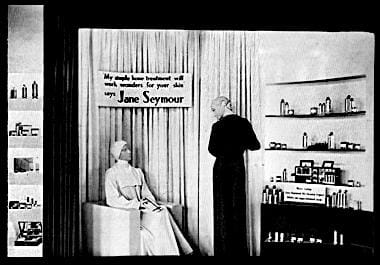
1935 Jane Seymour window display.
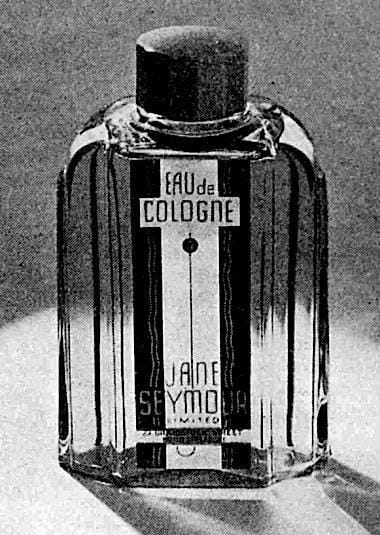
1936 Jane Seymour Eau de Cologne.
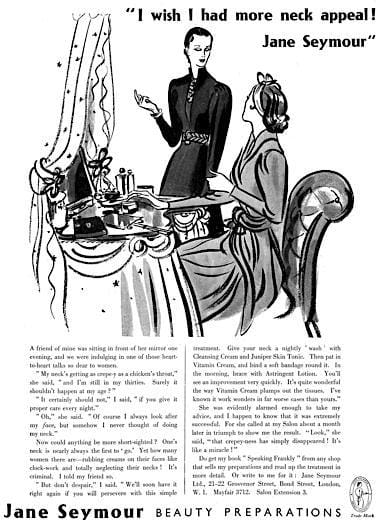
1937 Jane Seymour.
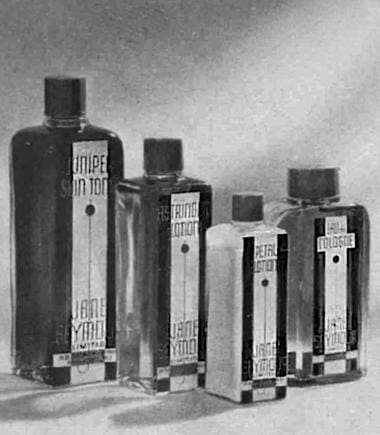
1938 Jane Seymour Juniper Skin Tonic, Astringent Lotion, Petal Lotion, and Eau de Cologne.
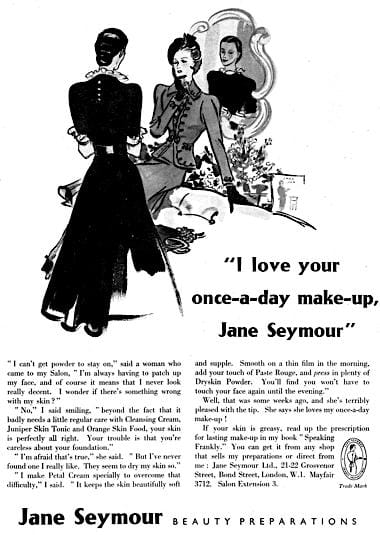
1938 Jane Seymour.
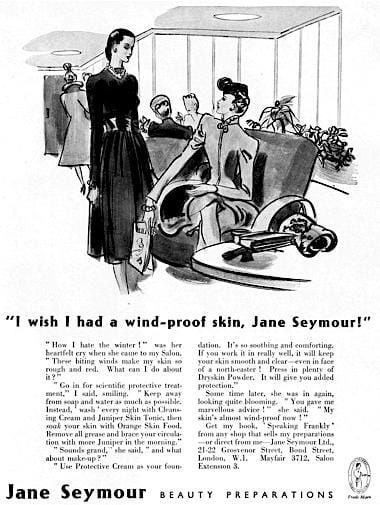
1939 Jane Seymour.
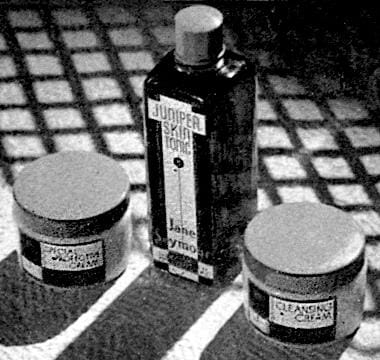
1939 Jane Seymour Special Protective Cream, Juniper Skin Tonic, and Cleansing Cream.

1939 Jane Seymour (Australia).

Above: Jane Seymour window display at the Farmer’s Department Store, Pitt Street Sydney.
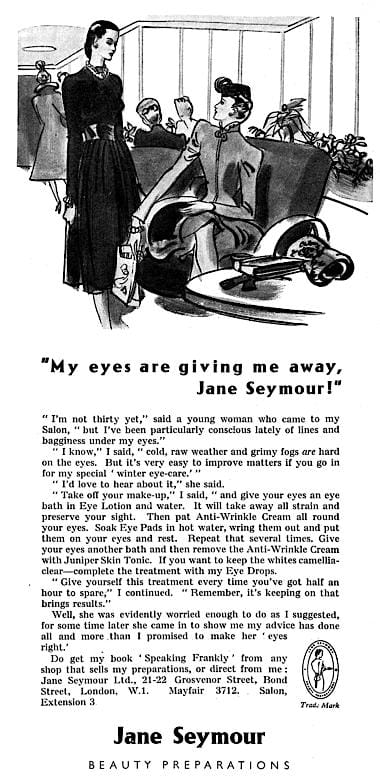
1939 Jane Seymour.
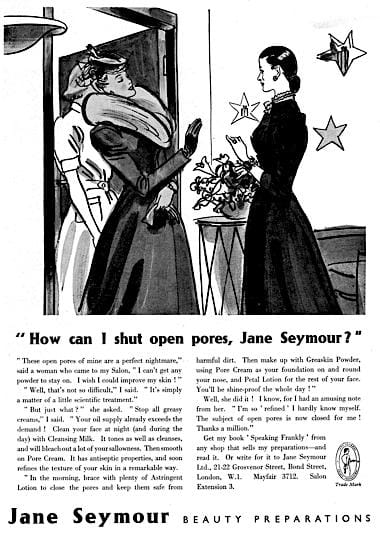
1939 Jane Seymour.
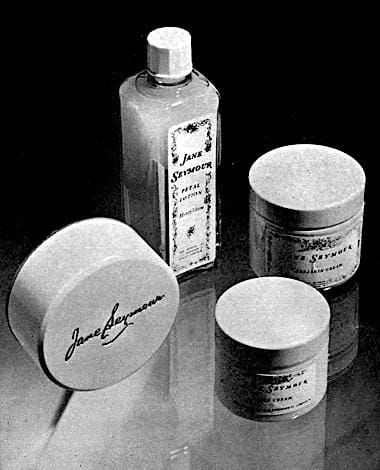
1951 Jane Seymour Greaskin Powder, Petal Lotion, Greaskin Cream, and Pore Cream in new packaging before the labels were updated.
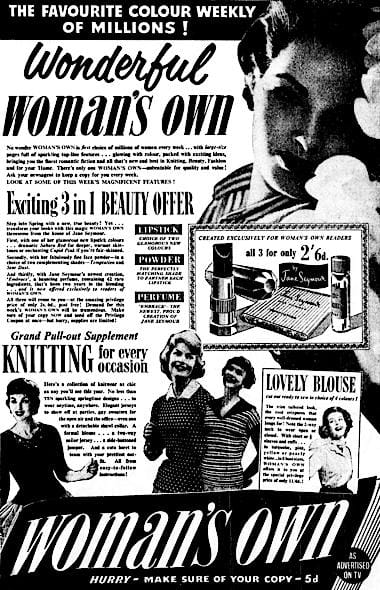
1958 Jane Seymour 3 in one beauty offer with Woman’s Own magazine.

1958 Close-up of Jane Seymour 3 in 1 beauty offer with Woman’s Own magazine. The top of the lipstick case looks very similar to the one produced by Goya for its Kiss lipstick in 1956.

1959 Jane Seymour Wonder Girl.
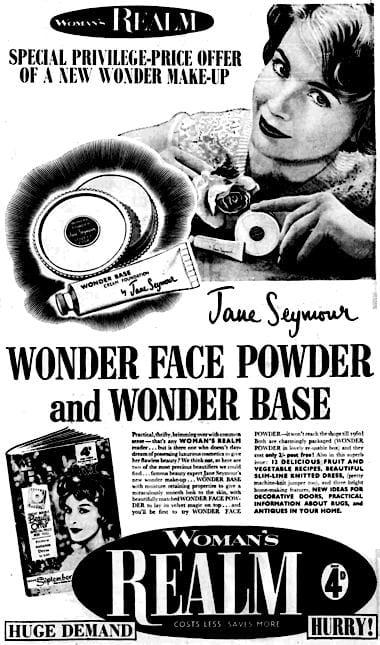
1959 Jane Seymour privilege-price offer with Woman’s Realm magazine.

1959 Jane Seymour Lipstick and White Wonder.
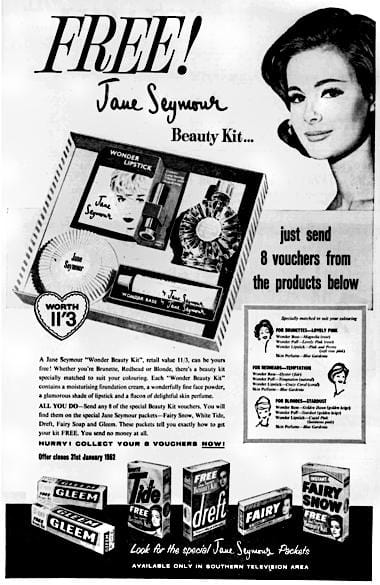
1961 Jane Seymour Beauty Kit.
